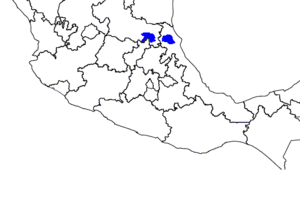Huastec language facts for kids
Quick facts for kids Wastek |
|
|---|---|
| Huasteco Teenek |
|
| Native to | Mexico |
| Region | San Luis Potosí, Veracruz and Tamaulipas |
| Ethnicity | Huastec |
| Native speakers | 170,000 (2020 census) |
| Language family |
Mayan
|

Approximate extent of Huastec-speaking area in Mexico
|
|
The Huastec language (also called Wasteko or Teenek) is spoken in Mexico. It is the language of the Huastec people, who live in the countryside of San Luis Potosí and northern Veracruz. Even though it's a bit far from other Mayan languages, it's actually related to them. These other Mayan languages are spoken more to the south and east in Mexico and Central America.
In 2005, about 200,000 people spoke Huastec in Mexico. Around 120,000 of them lived in San Luis Potosí, and about 80,000 lived in Veracruz. The name Teenek is becoming more common for both the language and the people who speak it.
There was once a language called Chicomuceltec language, spoken in Chiapas and Guatemala. This language, which is now extinct, was very similar to Wasteko.
The first person to write down how the Huastec language worked for Europeans was Andrés de Olmos. He also wrote the first grammar books for the Nahuatl and Totonac languages.
You can even hear programs in the Wasteko language on the radio! The CDI has a radio station called XEANT-AM in Tancanhuitz de Santos, San Luis Potosí, that broadcasts in Wasteko.
Contents
Huastec Language Dialects
A dialect is a different way a language is spoken in different places. Huastec has three main dialects. These different ways of speaking have developed over about 400 years. The language is spoken in a part of east-central Mexico called the Huaxteca-Potossina.
Western (Potosino) Dialect
This dialect is spoken by about 48,000 people. They live in nine towns in San Luis Potosí. Some of these towns include Ciudad Valles, Aquismón, and Tancanhuitz.
Central (Veracruz) Dialect
Around 22,000 people speak this dialect. They live in two towns in northern Veracruz: Tempoal and Tantoyuca.
Eastern (Otontepec) Dialect
This dialect is also known as Southeastern Huastec. About 12,000 people speak it in seven towns in northern Veracruz. These towns include Chontla, Tantima, and Tamiahua. More recently, some reports suggest there might be fewer speakers, around 1,700, mainly in villages within Chontla, Chinampa, Amatlan, and Tamiahua.
See also
 In Spanish: Idioma huasteco para niños
In Spanish: Idioma huasteco para niños

